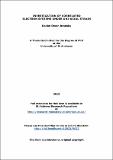Files in this item
Investigation of correlated electron systems under uni-axial strain
Item metadata
| dc.contributor.advisor | Mackenzie, Andrew | |
| dc.contributor.author | Brodsky, Daniel Owen | |
| dc.coverage.spatial | xii, 146 p. | en_US |
| dc.date.accessioned | 2016-10-07T11:38:48Z | |
| dc.date.available | 2016-10-07T11:38:48Z | |
| dc.date.issued | 2015 | |
| dc.identifier.uri | https://hdl.handle.net/10023/9622 | |
| dc.description.abstract | A central paradigm for classifying the phases of correlated electron systems is their symmetry. Having the ability to controllably tune symmetry-related properties of the system is therefore a powerful probe. In this thesis experiments on quasi-two-dimensional metals Sr₃Ru₂O₇ and Sr₂RuO₄ are reported, where uni-axial strain was used as a means of lifting the native tetragonal symmetry. Uni-axial strain was applied to the samples using a piezo-electric based device which can apply both positive and negative strains to the sample, to study the symmetry of the response about zero strain. Sr₃Ru₂O₇ exhibits a magnetic-field-tuned quantum critical point, in the vicinity of which a novel phase is stabilized. The transport properties of the phase were previously shown to be highly susceptible to in-plane magnetic fields. We show that resistivity inside the phase responds strongly to strain applied along one of the in-plane crystal axes, with the responses parallel and perpendicular to that of the applied strain mirroring each other about zero strain. Our results suggest that the underlying symmetry of the phase is C₄ rather than C₂ symmetric. Sr₂RuO₄ is an unconventional superconductor which was predicted to have an order parameter of the form pₓ ± ip[sub]y. This should result in a splitting of the transitions of the two components as a function of strain, with a cusp in T[sub]c versus strain at zero strain, where T[sub]c is the upper of the two transitions. We find that the response of T[sub]c to strain along [100] is large and symmetric about zero strain, whilst the response to [110] strain is weak and mostly anti-symmetric. No cusp is observed for either strain direction. We argue that although our results are in contradiction with the simplest pₓ ± ip[sub]y models, they may still be consistent with certain scenarios where the cusp would have been too small to be observed. | en |
| dc.language.iso | en | en_US |
| dc.publisher | University of St Andrews | |
| dc.subject.lcc | QC176.8E4B8 | |
| dc.subject.lcsh | Electron-electron interactions | en_US |
| dc.subject.lcsh | Strains and stresses | en_US |
| dc.title | Investigation of correlated electron systems under uni-axial strain | en_US |
| dc.type | Thesis | en_US |
| dc.contributor.sponsor | Engineering and Physical Sciences Research Council (EPSRC) | en_US |
| dc.contributor.sponsor | Scottish Universities Physics Alliance (SUPA) | en_US |
| dc.contributor.sponsor | Scottish Doctoral Training Centre in Condensed Matter Physics (CM-CDT) | en_US |
| dc.contributor.sponsor | Max-Planck-Gesellschaft zur Förderung der Wissenschaften | en_US |
| dc.type.qualificationlevel | Doctoral | en_US |
| dc.type.qualificationname | PhD Doctor of Philosophy | en_US |
| dc.publisher.institution | The University of St Andrews | en_US |
This item appears in the following Collection(s)
Items in the St Andrews Research Repository are protected by copyright, with all rights reserved, unless otherwise indicated.

